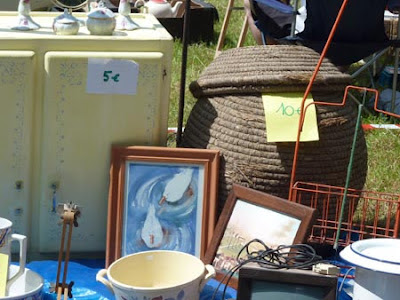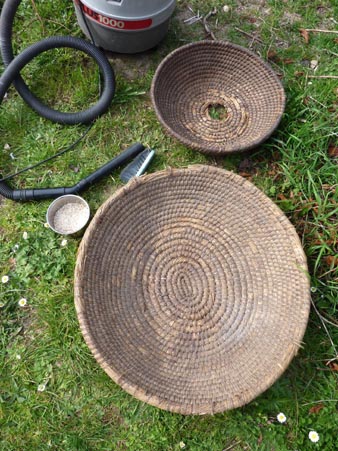Its cooler, the nights are closing in on the days and the bric-a-brac season in the Charente is, thankfully, coming to an end.
It has been a good summer for the local ‘brocanteurs’ wanting to offload their abused traditional straw baskets and now I have more than I really know what to do with in the basket sanctuary. There is no need for me to seek these baskets out at bric-a-bracs as they seem to find me quite easily. I can hear them calling out to me from under tables or behind boxes, it’s a plaintive attention seeking cry and I appear to be the only person that hears it. Sometimes I try to walk past them, but the cry just gets louder and more distressing. Occasionally they use their charms on me and it’s as though I have caught the eye of an attractive stranger across a crowded room. I look away but within minutes I cannot resist looking back to find them working their spell.

Each basket is different, with its own personality. There are solid, rough, rustic ones made by impatient people with big hands. And there are fine ones made with thinly pared strips of ronce (bramble) and stitches so close together that the maker must have spent a whole winter making it. I try not to buy two the same shape or form but sometimes I do, because each one was made by a different person and they all have their individual characteristics.
When I bring them home I give them a good dusting with a bristle brush, then a hoover, followed by a bath in cold rain water, as they are always filthy, then they are left to dry naturally in a warm sunny spot. It may not be an orthodox conservation technique but they seem to like it and come out shiny and warm and smelling like hay. Sometimes they have evidence of woodworm, but if the suction and drowning haven’t killed any live larvae then drying out the basket properly will usually make them move home because they prefer moist materials.
The injuries will take longer to deal with as there are feet and bottoms missing and cuts around the mouths. At the moment I see two options. They can either be stitched back together in the traditional way, with straw and split ronce, or they can be repaired with other materials in such a way that it draws attention to their scars and makes the viewer see them differently and not just as old baskets repaired. These ‘old’ baskets were young once and served their families well for many years, now they deserve to be respected and celebrated and given some tlc because they have tales to tell us of past lives we can hear no other way.
Lois Walpole, Britain

PROFILE
Lois Walpole is of Anglo Scottish heritage and trained in Sculpture, Basket Making and Design.
She works full time as an artist/basket maker taking part in and curating national and international exhibitions, working to commission, designing for production, teaching and writing.
She divides her time between the Shetland Islands and the Charente, in south west France, where her studio is based.
Her blog gives the latest about her teaching and exhibitions and is where she talks about the baskets and basket related things that she finds interesting, inspiring, infuriating and intriguing…
Her self imposed rules are “no materials purchased and basket making techniques employed wherever possible”.



